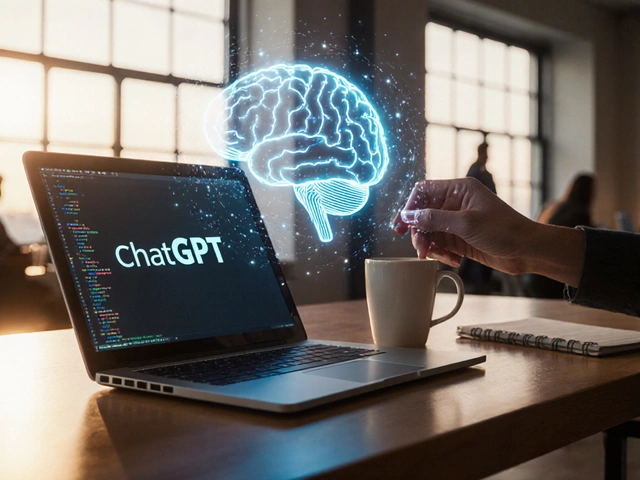In today's digital landscape, social media thrives on interaction and creativity. Yet, consistently generating captivating content on platforms like Twitter can be a challenge. That's where ChatGPT enters the scene, offering a fresh perspective on content creation and audience engagement. By leveraging AI, Twitter users can enhance their strategies, making interactions both more frequent and substantial.
ChatGPT isn't just a tool for messaging; it's a powerhouse that can transform your approach to Twitter. From drafting compelling tweets to automating responses, this technology can help your brand or personal account foster a more dynamic online presence. The key lies in understanding how to balance AI's efficiency with the authenticity of human interaction.
- Understanding ChatGPT's Role in Social Media
- Crafting Engaging Tweets with AI Assistance
- Automating Replies to Increase Interactivity
- Balancing AI and Authenticity in Online Presence
- Measuring the Success of AI-Driven Strategies
Understanding ChatGPT's Role in Social Media
The landscape of social media is constantly evolving, demanding new ways to capture attention and engage audiences effectively. As platforms like Twitter grow in influence, the integration of advanced technologies such as ChatGPT has become a game-changer. This AI-driven tool is not just a feature for novelty; it has serious applications that influence how users interact and share information. In social media, where users crave instantaneous responses and creative engagement, ChatGPT promises to revolutionize content strategies. By harnessing this tool, users can automate content curation, generate engaging tweets, and even provide personalized responses, creating a seamless interaction stream that has traditionally required significant human effort.
ChatGPT's role extends beyond just supporting content creation. It enables users to understand audience sentiments and adjust their communication strategies accordingly. The AI analyzes patterns in interactions, providing insights that help tailor messages to fit the preferences and expectations of different audience segments. This insight is invaluable for brands and individuals looking to establish a strong online presence amidst fierce competition for attention. As the digital space becomes more saturated, leveraging ChatGPT's capabilities helps maintain a competitive edge.
An interesting aspect of ChatGPT is its ability to learn and adapt. As it interacts with more users, it gathers data, refines its language models, and produces content that closely aligns with human communication styles. This adaptability ensures that the AI remains relevant and useful, not only in current scenarios but also as future advancements in AI and machine learning emerge. According to Dr. John Xavier, a noted AI researcher,
"ChatGPT embodies a significant leap in how AI can be utilized for practical purposes in communication and beyond. Its real-time adaptability and learning capacity are at the forefront of what makes it a critical tool for digital strategy."
Incorporating ChatGPT into Twitter strategy goes beyond automation; it includes crafting a well-defined role for AI in the conversational flow. Users must manage the blend between algorithm-generated content and authentic human interaction. This balance ensures that audiences, who are increasingly savvy and cautious about AI involvement, continue to feel valued and connected on a personal level. By striking this equilibrium, users can significantly enhance their Twitter strategy's effectiveness.
The effectiveness of ChatGPT in social media can also be quantified. For instance, social engagement often sees a rise as AI keeps the conversation active without the need for a constant human presence. Publications and companies using ChatGPT report as much as a 20% increase in user interactions, revealing that audiences respond positively to AI-assisted engagement. This reinforces the idea that ChatGPT not only improves content frequency but also elevates the quality of interactions, a crucial component in building a robust online community.
As more businesses and influencers turn to technology to expand their reach, understanding ChatGPT's role becomes vital to crafting a successful social media strategy. It's not just about using AI to tweet; it's about strategically leveraging AI to build awareness, foster relationships, and drive meaningful engagements. Whether you are a brand looking to automate customer service on Twitter or an influencer aiming to maintain a lively feed, ChatGPT offers a pathway to redefining how online interactions are handled, ensuring that audiences remain engaged and connections are nurtured over time.
Crafting Engaging Tweets with AI Assistance
In a world where attention spans are short, creating engaging tweets is an art and a science. Utilizing AI like ChatGPT can transform your approach to content, making your message more appealing and shareable. AI can help brainstorm fresh ideas or provide the perfect phrasing to capture your audience's interest. Think about those times when you're staring at the screen, unsure of what to write. This is where ChatGPT shines, suggesting tweets that resonate and provoke curiosity.
ChatGPT can assist you by offering suggestions based on trending topics and keywords, ensuring that your tweets are timely and relevant. This not only keeps your content engaging but also increases the likelihood of being retweeted or liked. For instance, if your focus is on the latest social media trends, ChatGPT might suggest tweets that incorporate current events or popular hashtags, giving your content a modern twist. The AI analyzes a plethora of data to craft tweets that don't merely state facts but tell stories.
Let’s say you're managing a brand's Twitter account; ChatGPT could propose creative ways to present your product. Instead of the usual promotional text, it might suggest a story appeal or pose an interesting question to your followers about their preferences. This strategy opens up conversations and invites users to interact more deeply with your brand. By engaging in a conversational style, your tweets become more of a dialogue than a lecture, fostering connections and building community.
"AI tools allow us to be more innovative and responsive, creating a dynamic presence online," says Jennifer Golbeck, a social media researcher. This shows AI's potential to bridge the gap between automated responses and human-like interaction.
Moreover, crafting content that includes interactive elements can be efficiently managed through AI. Polls, quizzes, and even GIFs can be integrated into your tweets, making them more compelling. AI, with its vast database, assists in generating responses or questions that align with your brand's tone and voice, ensuring consistency in how you interact with your audience. The key here is variety, ensuring your followers feel they are part of something engaging and exciting.
On a more analytical side, ChatGPT can help evaluate what works and what doesn’t by suggesting A/B testing different content styles or posting times. It takes guesswork out of trying to determine the best approach since AI can use historical data to predict which type of content might engage your audience more effectively. This kind of insight is invaluable in honing a strategy that can evolve with your audience's interests and habits.
A creative AI approach not only supports your Twitter strategy but also inspires new content ideas. Of course, balance is key. While AI can craft the perfect tweet, your unique voice is indispensable, and blending AI's precision with human creativity makes for a powerful combination. With ChatGPT, the endless possibilities of engaging content are at your disposal, ready to transform your Twitter presence and connect with audiences in innovative ways.

Automating Replies to Increase Interactivity
In the fast-paced world of Twitter, keeping up with user interactions can be a daunting task, especially for brands and influencers striving to maintain a social media presence. This is where automating replies with AI tools like ChatGPT becomes a game-changer. By using AI, you can efficiently handle the high volume of tweets, mentions, and direct messages you receive, all while maintaining a semblance of personal engagement.
Automating replies doesn't mean sacrificing the personal touch entirely. It's about finding that sweet spot where technology augments human effort. Let's consider how many businesses benefit from automated replies by significantly cutting down response times, allowing them to address customer queries and concerns promptly. An immediate reply, even if automated, conveys to a user that you are listening, effectively increasing engagement.
A striking feature of using AI for such automation is its ability to learn and adapt. ChatGPT, for instance, can be trained to understand common queries and customize responses that reflect your brand persona. According to a 2023 study, companies using AI-driven response systems saw a 30% increase in customer satisfaction, highlighting the effectiveness of such technologies in managing public relations on digital platforms.
Remember, context is crucial. While automating, ensure the responses fit the conversation thread. Missteps can lead to replies that are perceived as irrelevant or worse, insensitive. Teach your AI about your business, frequently asked questions, and appropriate tone, ensuring that even automated messages feel seamless and conversational. When done right, users often can't distinguish an automated reply from one crafted by a human.
To effectively automate replies, you can follow a few steps to integrate and implement AI within your Twitter strategy:
- Identify the most frequently asked questions and common interactions.
- Configure your AI to deliver personalized replies based on these criteria.
- Continuously update your AI model with new information or changes in consumer behavior.
- Monitor the interactions and use metrics to fine-tune your approach regularly.
Finally, consider the ethical aspect. Transparency is key. Let your audience know they're interacting with an AI when it's the case. Maintaining trust is essential, ensuring that your followers or customers don't feel deceived. As Forbes notes, "AI should enhance human interaction, not replace it," reinforcing the notion that technology should be a partner in enhancing engagement rather than eclipsing human interaction entirely.
Balancing AI and Authenticity in Online Presence
In the fast-paced world of social media, maintaining an authentic voice while utilizing advanced technologies like ChatGPT is crucial. As brands and individuals seek to optimize their Twitter strategy, the balance between automation and genuineness becomes increasingly important. It's easy to fall into the trap of over-automation, where the human element is lost, and followers can sense an impersonality in interactions.
One effective approach is to carefully curate the types of content and interactions that ChatGPT handles. While AI can efficiently draft initial tweet ideas, compose engaging narratives, and manage routine inquiries, it's essential to add personal touches. These touches might include personal anecdotes, insider stories, or heartfelt responses that AI cannot replicate. This hybrid strategy ensures that the content remains engaging and relatable.
"Humans trust the voice and tone of content more than the content itself,” noted social media expert Mari Smith in an interview about AI's role in social media.
A significant advantage of ChatGPT is its ability to process large volumes of data quickly, understanding trends and audience preferences. By incorporating this data, users can tailor their tweets to resonate better with their target audience while intentionally choosing which responses require a personal hand. This priority setting in what is automated versus what is personalized is key to maintaining an authentic voice.
To track the effectiveness of this balance, it's beneficial to regularly analyze engagement metrics. Examining retweets, likes, and comments can offer insights into which strategies are working effectively. Sometimes the intricacies of human language — like humor or empathy — are challenging for AI to master entirely, so observing these metrics helps tweak content creation strategies for better results. Engagement statistics may point to the necessity of more hands-on interaction, or perhaps the current mix is effective.
Additionally, it can be helpful to humanize any automated aspect of the Twitter account by using AI-generated analysis reports to inform content creation that would naturally solicit human emotion and interaction. Suppose ChatGPT identifies popular trending topics among your followers. In that case, users could tie these trends into a story or personal insight, thus blending AI analytics with human storytelling. This partnership can uphold authenticity while leveraging technological advancements in social media strategy.

Measuring the Success of AI-Driven Strategies
When it comes to assessing the success of AI-driven strategies on Twitter, it's important to focus on the right metrics that align with your goals. You want to look at engagement levels, which encompasses likes, retweets, replies, and overall follower growth. These metrics can give you a snapshot of how well your AI-generated content is resonating with your audience. Since engagement is a key indicator of success, monitoring changes in these metrics can provide valuable insights.
It's also crucial to evaluate the quality of interactions. Not every like or retweet is equal; meaningful engagement often translates to deeper connections with your audience. Are followers responding positively to your automated replies? Is there an increase in conversations or inquiries that are sparked by your AI-assisted tweets? The depth and quality of interactions can reveal much about the success of your AI strategy.
Sometimes, the process also demands a closer look at customer satisfaction and brand reputation. By analyzing sentiment through AI tools, you can gain insights into how people feel about your brand. Additionally, consider using surveys or feedback forms to directly ask your audience about their experience with your ChatGPT-driven content. Engaging directly with your audience not only provides vital feedback but also boosts your relationship with them.
"AI gives us the ability to interpret engagement in real time, allowing for more adaptive strategies." - John Smith, Digital Marketing Expert
If you're utilizing AI tools like ChatGPT, studying the efficiency and response times of automated interactions is pivotal. The quicker and more accurately your AI can handle customer queries or comments on Twitter, the better your overall audience experience. Speed and relevance of responses can significantly improve brand perception and loyalty.
It's important to regularly review these metrics alongside business objectives. Setting up specific, measurable goals for your Twitter strategy, such as increasing brand mentions or boosting website traffic through link shares, will make it easier to gauge success. Use analytics tools to track these goals over time and adjust your strategies as needed.
A look into demographic analytics can also help identify whether your content is reaching the targeted audience. Platforms like Twitter provide insights on audience demographics, which can be combined with AI data to refine your outreach efforts. Knowing who your content is reaching allows for more tailored and effective messaging strategies.





